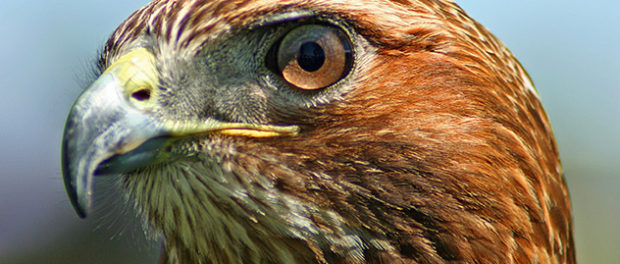Getting to know the red tail hawk

If you’ve ever seen a movie in which a hawk or an eagle appears, or the camera pans a mountain and valley landscape, then you’ve probably heard the thrilling, raspy scream of a red tail hawk; despite the type of bird depicted on screen.
According to the Audubon Society, the red tail hawk is probably the most common hawk in North America. They are large hawks in the Buteo family and have very broad, rounded wings and a short, wide tail.
Most red tail hawks have a rich, brown coloring to their backs and are pale underneath. They have a streaked belly and on the underside of the wing, a dark bar runs between the shoulder and the wrist. Usually, the tail features are pale below and a cinnamon-red above.
This bird of prey prefers open country and is commonly seen perched on fence posts or solitary trees along the edges of a field or the side of the road.
If you keep a sharp eye out during a road trip, you’ll see several red tails taking advantage of the thermals [a current of warm air] and soaring high above you or perched and waiting for food.
These birds do most of their hunting by watching from high perches such as a telephone pole before swooping down to capture its prey with its sharp talons.
They feed on small mammals, other birds and reptiles and their diet varies with location and season. Although voles, rats, rabbits and squirrels make up the majority of their prey, red tails have been known to eat bats, frogs, insects and possibly carrion.
When they are courting, red tail hawks put on a display. They soar in wide circles at great heights at which point the male dives sharply before shooting up again at an equally steep angle. After a few swoops, he approaches the female and extends his legs to touch her briefly from above.
Some birders have observed mating pairs grabbing onto each other by grasping their talons and plummeting in a spiral toward the ground before pulling away.
Both the male and female red tails help build the nest, and in some cases, they refurbish a nest they’ve used in previous years. Red tail hawk nests can be up to 6.5 feet high and 3 feet wide and are built from dry sticks, bark strips, fresh foliage and dry vegetation.
During the breeding season, red tails usually have only one brood with an average of two to three eggs. Tiny and helpless when they hatch, the female remains with the young most of the time during the first few weeks.
After that, food is dropped in the nest and the young learn to feed on it by themselves.
They are usually ready to leave the nest about six to seven week after hatching, but remain with the parents for several weeks as they grow their strength and learn to live on their own.
Although their population is stable in Tennessee, it is against the law to kill, injure or capture any bird of prey, including the red tail hawk, according to the Tennessee Wildlife Resource Agency.
The bird is a permanent resident statewide, and a population that is on the rise in many parts of the state, so next time you’re on the road, take a moment to look up and more than likely, you’ll get the chance to see a red tail hawk soaring high above.
Click here to read the original article, published online at The Ledger, Friday, May 13.
Leave a comment